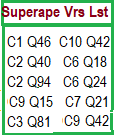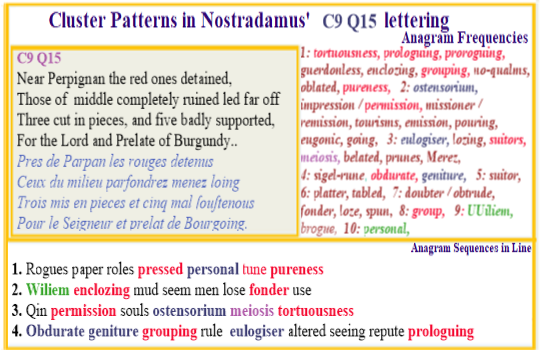 Analyses of all verses
Analyses of all verses
|
 Web Site
Web Site |
 All
Sefirots All
Sefirots |
Nostradamus C9 Q15: The personal impacts of human induced evolutionary change
Copyright: Allan Webber, December 2015, Feb 2023
 The
consistent theme in this verse's anagrams is evolution.
The
consistent theme in this verse's anagrams is evolution.
Four anagrams vital to this conclusion are those for personal (pan les ro), in the first line, eugonic (oing Eu) in the second, meiosis ( ois mis) in the third and geniture (igneur et) in the last line. This verse and its pair named alongside present details related to the early presence of the superape species.
Meiosis is a critical process in the earliest stages of sexually reproducing organisms as it controls the copying of chromosomes while geniture relates to the resulting continuance in the genetic lineage of the progeny born through sexual reproduction.
The term geniture consistenly occurs in verses where the superape anagrams are found.
And eugonic is used for biological processes conducted outside the natural site in an artificial medium.
The term personal in the first line suggests the process involves the human species since it is of direct relevance to Nostradamus and his kin while eugonic meiosis is suggestive of artificial modes of conception.
Combining the above idea of location seen in the verse's text with that of evolution suggests this verse has the potential to tell future readers when and where in our century the evolution of a new species will commence. This interpretation allows the otherwise quite difficult text to be read with greater ease.
Therby the red ones detained are members of a new species. Those in the middle ruined and led off are the people linking humankind who are killed or die because of their part in bringing the new species to fruition.
My choice that these terms relate to evolution rather than ordinary reproduction is significantly shaped by the importance required for any topic to to be part of Nostradamus' limited wording.
Another factor is the impresssion made by the patterns found throughout his work with mutation being one of his prominent focuses.
And in addition topic of lesser import has diminishing relevance to anyone the further it is from the 1550's.
 That
same idea of a hidden message about mutation can be seen within the
sequence in line 4 where geniture appears together with
obdurate seeing rules altered
( at de
Bour / Seign e / ur le / relat de).
That
same idea of a hidden message about mutation can be seen within the
sequence in line 4 where geniture appears together with
obdurate seeing rules altered
( at de
Bour / Seign e / ur le / relat de).
The foregoing finds its own support within the anagrams since impression (rois mis en p) in line3 and grouping (urgoing P) in line 4 also implies impressions are created by patterns.